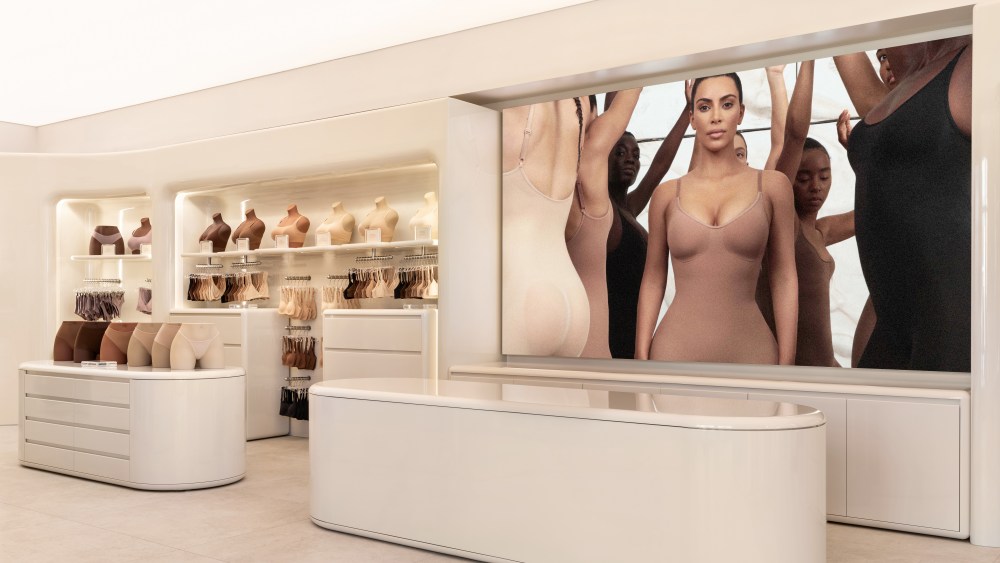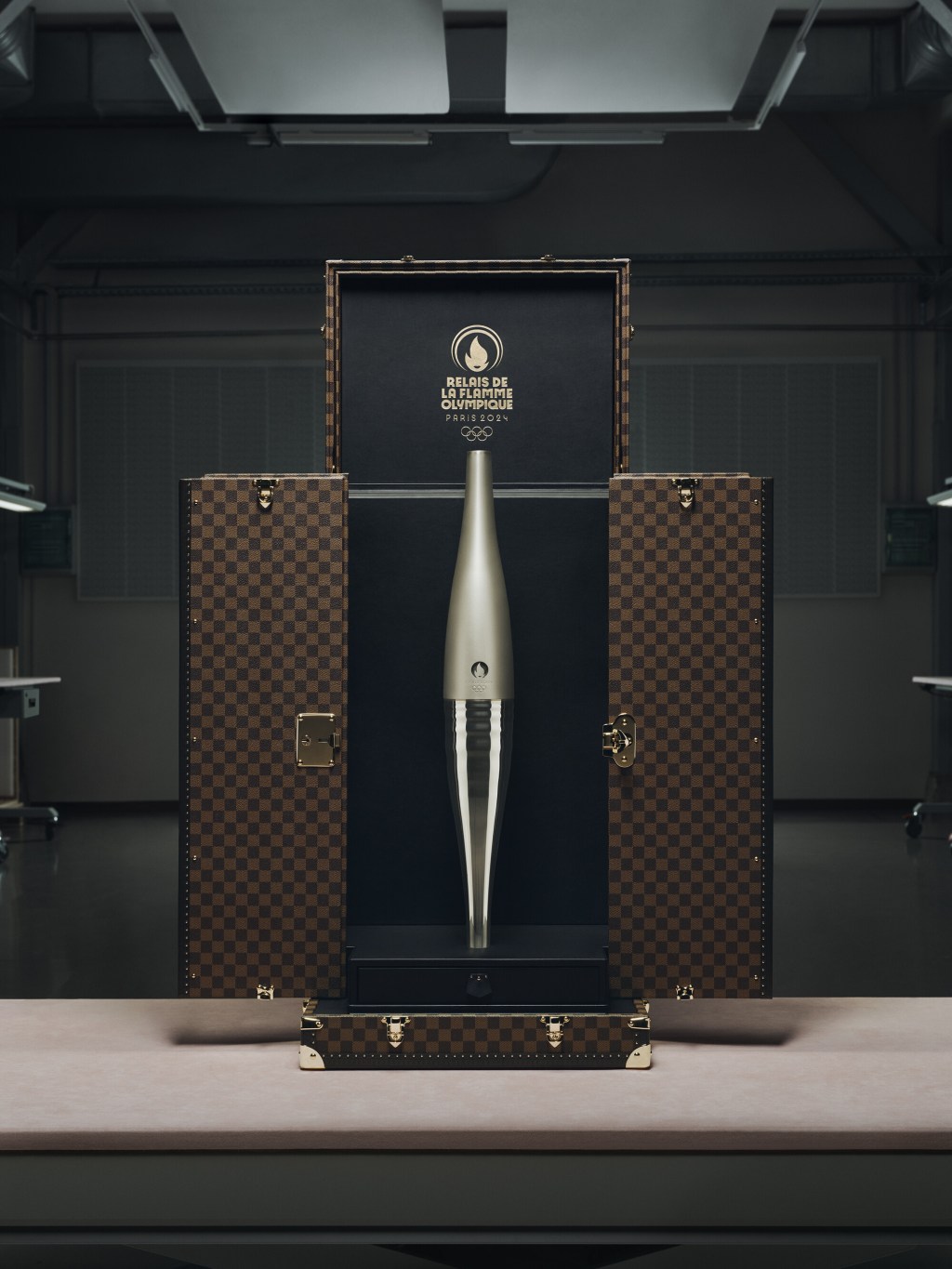With an eye toward an IPO, Kim Kardashian’s Skims is getting serious about the brick-and-mortar game.
Thursday, the brand will open its first permanent store in Georgetown, D.C., followed this summer by Aventura, Fla.; Austin; Houston; and Atlanta.
The Georgetown store, which spans 3,300 square feet, will carry women’s products. The plan is to introduce men’s to the store in the third quarter. The store will feature select drops, but the majority of the assortment will be the core collections.
Skims designed the mall doors in partnership with Willo Perron of Perron-Roettinger. The interior is an extension of the brand’s signature rounded edges and glossy surfaces seen in past pop-ups and in their multibrand shop in shops across the globe.
You May Also Like
This isn’t Skims’ first step into physical retail. Over the years, the brand has had four stand-alone pop-ups: a pop-up at The Grove in Los Angeles in 2021; a Skims Swimwear pop-up in the Miami Design District and a Skims summer pop-up at Rockefeller Center in New York, both in 2023.
Skims has also executed pop-ups for collaborations including Fendi x Skims that spanned over 13 cities in 2021 and Swarovski x Skims in eight cities in 2023. There have been Skims’ pop-ups in Nordstrom’s The Corner in New York; Ounass in Dubai; Lane Crawford in Chengdu, China; and Selfridges Corner Shop.
Now they’re thinking permanent shops.

For their upcoming brick-and-mortar stores, there’s a 3,721-square-foot store that will open in Aventura June 27; a 3,382-square foot store that will open in Austin in July; a 6,909-square-foot store that will be unveiled in Houston in August, and a 3,500-square-foot store that will debut in Atlanta in September.
Explaining what motivated Skims to enter brick-and-mortar, Robert Norton, Skims’ chief commercial officer, told WWD, “We’ve been a very successful digital-native brand, but we knew that in order to unlock the next phase of growth, it was imperative that we engage, connect and really build a deeper relationship with the consumer and potential consumers on a physical level.”

The company is taking a two-prong approach to retail by developing flagships at the same time as locations in key urban markets around the U.S. The approach is to learn, test, have agility and apply their learnings, he said.
In determining the first five urban locations, Norton said, “We wanted a mix of street locations that were proven street locations with high tourism, great local consumer base, and a very broad demographic of consumers coming in. With that said, Georgetown’s Main Street is one of those streets,” he said.
Whether he prefers main streets to malls, Norton said they want to go “where the customer is at.” Of the first five, two are on the street, and three are in malls (Aventura Mall in Miami, The Galleria in Houston, Lenox Square in Atlanta).
Asked why they chose these first five stores, Norton said it was a combination of good real estate, demographics, the right economics, and the customer base in these markets. “These markets have really good starter positions for us,” he said.
Six months ago Skims opened a pilot store in Austin to understand how the customer responds, what do they want, what does IT (Information Technology) look like, and operationally how do they support it. “We’ve been operating in the background and piloting and testing for six months,” he said. He said it’s a different concept that they’ll have for flagships, with a different team. “Kim is very involved in both iterations of the brand [urban stores and flagships] as we further develop who we are physically, and really drive that brand ID,” he said.
As for what learnings they came away with, he said some of it was Retail 101, operational fluidity and friction points around retail. They also learned a lot about assortments, what the customer responds to, what repeat business they do and what they come in for. He said they’re starting to understand those journeys between online and offline, and getting sharper with retention efforts.
Asked where they’re seeing most of the action in the test store, he said, “It’s really a balance of our core iconic products and newness, which is no surprise.” He said he’s seeing a nice uptick in new acquisitions [of customers]. They are coming in for shapewear, T-shirts, bodysuits that can be worn out, and basics to refill their drawers. “What we’ve seen in performance in Austin is very in line with our digital businesses, with a split between lounge and intimates, and of course our third pillar of shapewear,” he added.
Overall, Skims wanted to create a space where “when the customers leave they’re strong brand advocates actively promoting the brand.”
Horton sees brick-and-mortar as an important initiative for the brand. When asked how many stores he thinks Skims can support, Norton said, “Definitely over the next few years, we can support over 100 stores.” He said there are linear plans of growth within the vertical, “but the customer will tell us a lot.”
After this group of stores, he said they’ll look at the Northeast corridor, through the Midwest, the West Coast and the rest of the Southern cities.
Right now, the stores range in size from 3,200 square feet to 6,900 square feet. “What is the breadth of product and how does the customer react in our space will determine our strategy going forward,” he said.
Kardashian has built the five-year-old business with a mix of online popularity and commercial savvy that has disrupted innerwear and fashion. Her team includes cofounder Jens Grede and his wife, founding partner Emma Grede. The couple also cofounded Khloé Kardashian’s Good American denim brand and contemporary casualwear label Frame.
Last July, Skims raised $270 million from institutional backers, snagging a $4 billion valuation and setting the company up for an initial public offering. The brand, which represents an inclusive vision of beauty, from body shape to skin tone, is said to be growing quickly, with sales as of last summer seen growing to $750 million from $500 million in 2022.



